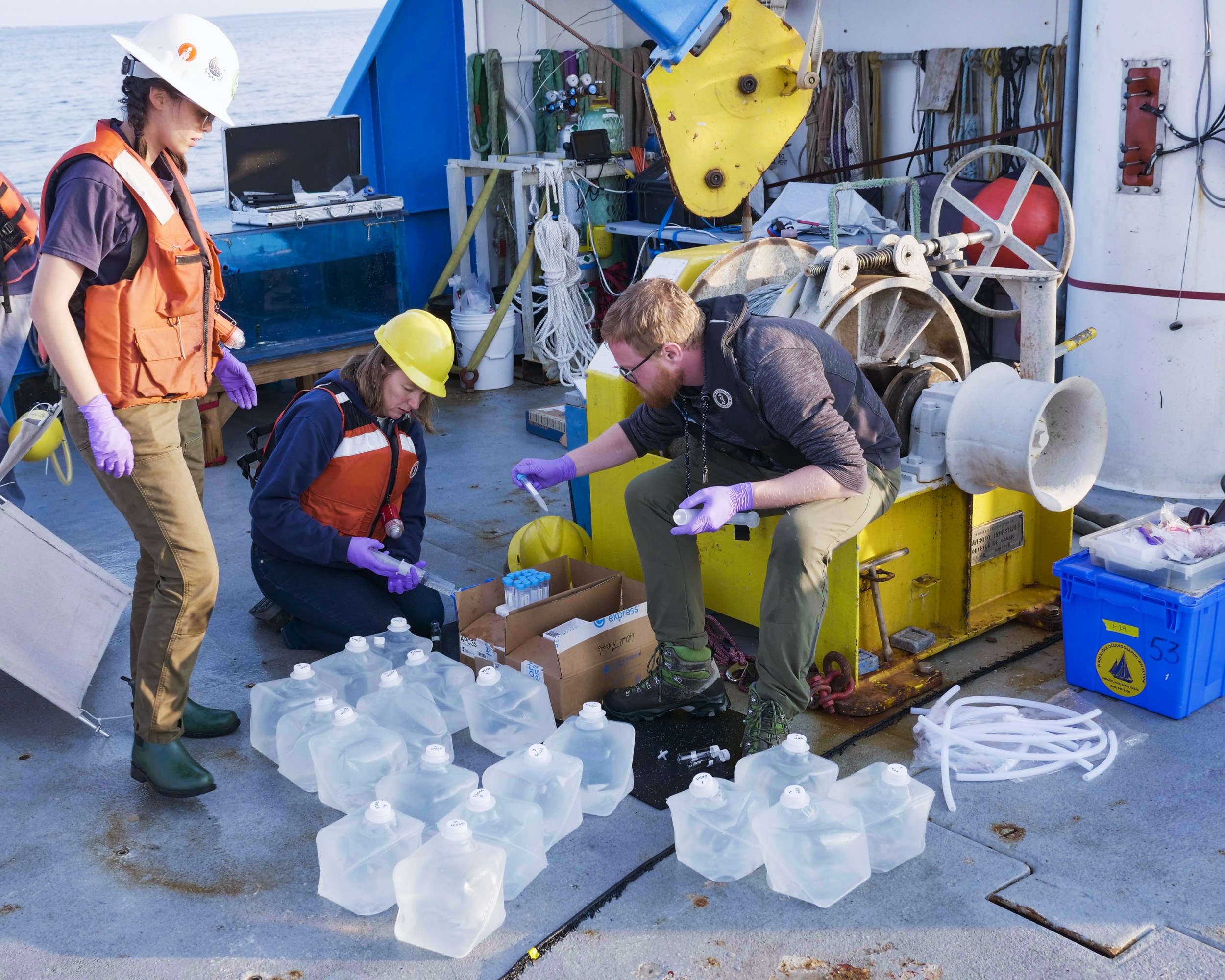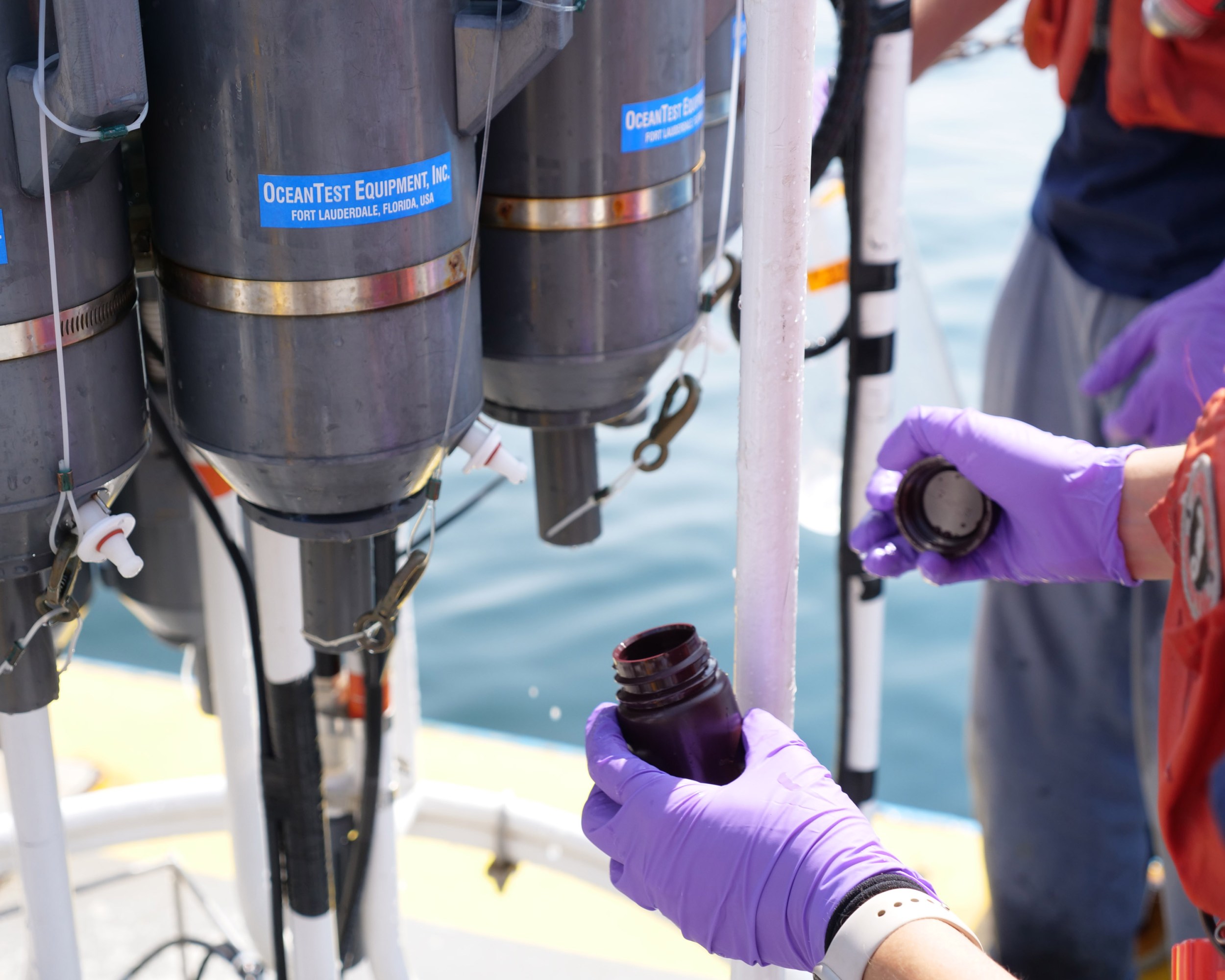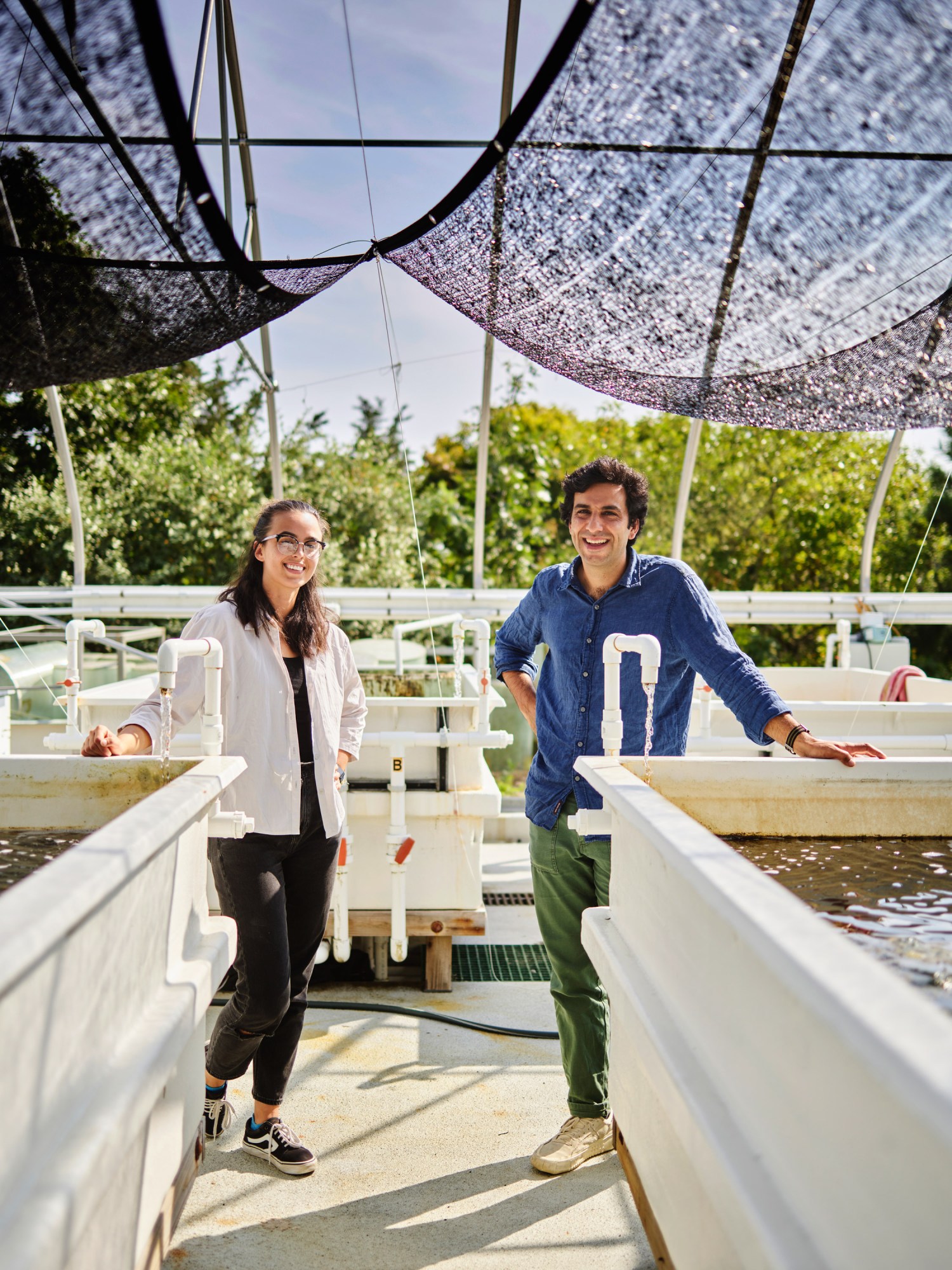Tapping into the ocean to combat climate change
Chloe Dean traces her decision to go to graduate school to the day a wildfire blazed through southern Oregon.
At the time, Dean was working as a lab technician at a hemp-processing startup in Oregon. She had studied environmental science as an undergraduate at the Oregon Institute of Technology but fell in love with chemistry. Working at the company was a good way to keep her lab skills sharp.
Meanwhile, Oregon was experiencing its worst forest fire season in living memory. On September 8, 2020, the Almeda fire swept through Rogue Valley, destroying 2,600 homes in a single morning. Dean was living 15 miles down the road.
For her, the fire was a wake-up call. It became “really hard for me to justify continuing working at this cannabis company,” she says. She’d been considering grad school, and that clinched it. So she ramped up her search for a program that would let her use her chemistry background to help combat climate change. She found it at Adam Subhas’s lab at the Woods Hole Oceanographic Institution (WHOI) in Falmouth, Massachusetts, and in 2021 she signed on as the lab’s first graduate student.
Dean is now in her third year in the joint MIT-WHOI program, where she is studying ocean chemistry and working toward her lab’s lofty goal: turning the ocean into a weapon against climate change.
Ocean acidification
The ocean serves as a vast reservoir of carbon, holding about 50 times more than the atmosphere does. And it plays a crucial role in the way carbon moves around on our planet. For example, seawater absorbs carbon dioxide from the atmosphere through molecular diffusion in colder waters such as those at high latitudes and releases it from warmer tropical waters. Biological mechanisms are also in play as photosynthetic plankton take in carbon dioxide and as dead organisms sink to the ocean floor and turn into carbon-rich sediment. All these processes, and many others, make up the oceanic carbon cycle.
Around 31% of all the carbon humans have emitted has dissolved into the ocean, and this dissolved carbon has driven up the ocean’s acidity by 30% in the last 200 years. Ocean acidification, as this phenomenon is called, dissolves shells, limits growth of coral reefs, and ultimately threatens to disrupt food chains on a massive scale. And it’s feared that when the ocean becomes overly acidic, its ability to absorb carbon could diminish—and the ocean might even begin to release more into the atmosphere.
But the ocean has ways of fighting back.
Dean first began studying ocean acidification as an undergrad when she spent a summer at the University of California, Santa Barbara, researching how the phenomenon affects kelp. To her surprise, she found that the geochemistry of kelp forests makes them naturally resistant to acidification. The sediment around the seaweed is full of alkaline minerals that, when dissolved in the carbon-rich water, increase the water’s alkalinity to offset the acidity of the carbon.

This neutralization process forms the basis of Dean’s research today. The Subhas lab studies the oceanic carbon cycle, which includes this “canceling out” of dissolved carbon by dissolved alkaline minerals. As sediment dissolves and alkalinity increases, the ocean is able to pull more carbon dioxide from the atmosphere. Over millions of years, this keeps atmospheric carbon in check.
“The ocean has a bad case of heartburn,” Subhas says. “What we’re talking about is giving it Tums.”
But what if you could accelerate that process on a large scale by introducing vast quantities of alkaline substances like lime to the ocean? Theoretically, it could help mitigate acidification. Researchers are now giving the idea, first proposed in the 1990s, serious consideration. “The ocean has a bad case of heartburn,” Subhas says. “What we’re talking about is giving it Tums.”
What’s more, introducing alkaline substances to the ocean could bolster its natural tendency to sequester carbon. Researchers estimate that ocean alkalinity enhancement, or OAE, could pull several gigatons of carbon dioxide out of the atmosphere each year.

But while OAE advocates argue that it could mitigate ocean acidification and anthropogenic climate change in one fell swoop, introducing large amounts of any substance into the ocean could have unintended ecological consequences. So Dean is studying whether it’s possible to implement OAE without collateral damage to marine life.
Dean’s work focuses on coccolithophores, tiny plankton that sequester carbon by absorbing it from the atmosphere through photosynthesis. When they take in dissolved carbonate ions from the ocean to build their shells, however, they also effectively “use up” alkalinity that would otherwise increase the ocean’s ability to absorb carbon dioxide. Typically, photosynthesis absorbs more carbon than shell formation displaces, so coccolithophores generally serve as a carbon sink. But under certain conditions—such as low alkalinity—shell formation could hypothetically outpace photosynthesis and cause coccolithophores to make the ocean less efficient at absorbing carbon.
This delicate balance means it’s critical to understand the intricacies of the role these plankton play in the carbon cycle. Currently, Dean is working to shed light on a phenomenon that has vexed ocean scientists since the 1970s.
The top layer of the ocean, where coccolithophores are found, contains more dissolved calcium carbonate than water should be able to hold. For decades, no one was sure why, though some researchers had suggested that coccolithophores might be responsible.

For her research, Dean grew coccolithophores in water that was rich in carbon-13, an isotope of carbon that is easy to track. Then she put them in a tank with microzooplankton known to prey on them and tracked where the carbon-13 went. She discovered that when coccolithophores are eaten by the microzooplankton, their calcium carbonate–rich shells are quickly dissolved within the acidic pouch that forms in the tiny animals’ bodies to help them digest their prey. After digestion, the predatory plankton jettison the pouch’s contents, including the dissolved shell. Dean found that this simple process may account for as much as 30% of the dissolved calcium carbonate near the ocean’s surface. So if adding huge volumes of alkaline substances to the ocean were to harm coccolithophores, it could alter the carbon cycle so dramatically that OAE might not work at all.
Dean’s role will be to study ocean alkalinity enhancement’s effect on phytoplankton. “You can only learn so much from a lab study. At some point you have to go out,” she says.
Chloe Dean
This concern prompted Dean to work with Subhas and Aaron MacDonald, an undergraduate summer researcher at WHOI, to investigate precisely how OAE affects these phytoplankton. The team grew coccolithophores for four generations under both normal conditions and the high-alkalinity conditions that would be expected with OAE. They compared the cultures’ growth rates, their photosynthetic efficiency, and the rates at which they formed shells. They found that the coccolithophores were unaffected by the increase in alkalinity, which bodes well for the technique’s potential. But it’s unclear whether the delicate balance that keeps these plankton from releasing more carbon than they take in will persist when the technique is scaled up.
Dean hopes to be involved in answering that question soon. At press time, WHOI was seeking EPA approval to undertake the first open-ocean test of OAE in the summer of 2024. The LOC-NESS project (short for “Locking away Ocean Carbon in the North East Shelf and Slope”) calls for WHOI biologists, chemists, engineers, physicists, and geologists to release alkaline materials into federal waters south of Martha’s Vineyard alongside a harmless dye so they can track where it goes using satellite imaging. Then, on board a WHOI research vessel, they will simultaneously take measurements to quantify how much carbon dioxide can be pulled in through OAE and study the impact on the ocean. On shore, the team is using ocean models to guide the experiments and interpret the forthcoming results. Subhas is spearheading the project. Dean’s role will be to study OAE’s effect on phytoplankton communities, monitoring how the populations change and observing how it affects the crucial role these plankton play in the carbon cycle. “You can only learn so much from a lab study,” she says. “At some point you have to go out.”
Dean hopes that her research both in the lab and at sea will help guide OAE implementation and keep the ocean safe. It’s important that we better understand OAE’s impact on marine life, she says, before we scale up and “just start dumping alkalinity out there.”
An opportunity to educate
Dean has always been a passionate environmentalist. Growing up in Central Oregon with a love of the forest, she looked up to forest rangers as heroes and petitioned her mother’s landlord to implement a recycling system in their building. But her family did not always share her enthusiasm.
She remembers coming home from college, excited to tell them about the environmental science she’d learned, only to be met with indifference. When visiting relatives in Alabama, she told a family member about her major and the response was “Why don’t you study something that actually matters?”
Coming from a family that didn’t believe in climate change until recently, Dean found ways to talk about science without pushing skeptics’ buttons. She says she learned how to avoid being “too pushy,” and how to separate the science of climate change from the politics. Her passion for sharing her excitement about science led her to begin volunteering with the nonprofit Zephyr Education Foundation in Woods Hole shortly after she started at WHOI.

Zephyr takes middle school, high school, and college students on ocean “cruises” with Woods Hole researchers so they can watch marine science happen. The founder, Rob Reynolds, has been running the program for 14 years; his students explore the salt marsh around Woods Hole, take water quality measurements, and even use a dredge to collect and examine seafloor creatures.
Dean has become a regular on Reynolds’s cruises, and she enjoys the chance to introduce these students, many of whom are from low-income backgrounds, to marine science. “A lot of [these] people have never even been on a boat,” she says. Some “have never even seen the ocean.” As a first-generation college student from a working-class background, Dean says, she feels a connection to them.
And she sees such outreach programs as critical. “All this really cool science happens, but it really just stays in the ivory tower,” she says. “Scientists [need] to have these broader communication skills, where they can take their science outside of academia.” Introducing marine science to young people seems like a good way to do just that.
Reynolds says Dean is a hit with the students. “It’s kind of funny. I mean, I put my heart and soul into these trips,” he says. “And then I get an email from the teachers. They say, ‘Oh, Chloe was terrific.’”
Stronger together
Dean is grateful for the chance to work with Subhas (“I literally wouldn’t have wanted to work with anyone else,” she says). Living in Falmouth, however, can be difficult.
Because of restrictive zoning and the profitability of short-term rentals, Cape Cod suffers from a serious housing crisis. Add to this the high price of gas and food, and the cost of living skyrockets. When Dean started at WHOI, students in the MIT-WHOI joint program got a minimum stipend of $45,480. Although that’s higher than most graduate stipends in the US, it can still be hard for grad students to make ends meet on Cape Cod. A survey by WHOI found that 16% of its graduate students have been homeless while working there.
So Dean helped lead an effort to unionize the WHOI grad students. While WHOI was supportive, the issue of whether fellows could be part of the union proved complicated; as of early September, WHOI and the students were still seeking resolution on how to handle them. But WHOI announced a flat 10% stipend increase for all grad students in June, which it says was part of its annual review process and an effort to address the hardships faced by students living on Cape Cod. Dean, however, considers the raise a major victory for the unionization effort.
When she reflects on her work as a researcher fighting climate change and as a union organizer, the parallels seem clear to Dean. “I just see climate change as being this issue that can bring people together, similar to how a union can,” she says.
“It’s hard to be optimistic in today’s world,” she adds, but she’s convinced that the solution lies in community: “I want people to find ways to come together.”




